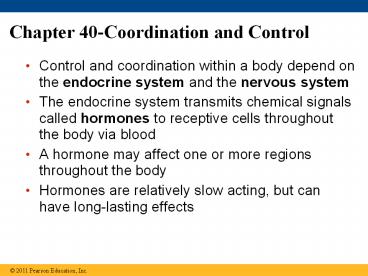Chapter 40-Coordination and Control - PowerPoint PPT Presentation
Title:
Chapter 40-Coordination and Control
Description:
Chapter 40-Coordination and Control Control and coordination within a body depend on the endocrine system and the nervous system The endocrine system transmits ... – PowerPoint PPT presentation
Number of Views:221
Avg rating:3.0/5.0
Title: Chapter 40-Coordination and Control
1
Chapter 40-Coordination and Control
- Control and coordination within a body depend on
the endocrine system and the nervous system - The endocrine system transmits chemical signals
called hormones to receptive cells throughout the
body via blood - A hormone may affect one or more regions
throughout the body - Hormones are relatively slow acting, but can have
long-lasting effects
2
Figure 40.6
3
Figure 40.6a
4
- The nervous system transmits information between
specific locations - The information conveyed depends on a signals
pathway, not the type of signal - Nerve signal transmission is very fast
- Nerve impulses can be received by neurons, muscle
cells, endocrine cells, and exocrine cells
5
Figure 40.6b
6
Figure 40.UN01
7
Feedback control maintains the internal
environment in many animals
- Animals manage their internal environment by
regulating or conforming to the external
environment - A regulator uses internal control mechanisms to
moderate internal change in the face of external,
environmental fluctuation - A conformer allows its internal condition to vary
with certain external changes - Animals may regulate some environmental variables
while conforming to others
8
Figure 40.7
9
Homeostasis
- Organisms use homeostasis to maintain a steady
state or internal balance regardless of external
environment - In humans, body temperature, blood pH, and
glucose concentration are each maintained at a
constant level
10
Mechanisms of Homeostasis
- Mechanisms of homeostasis moderate changes in the
internal environment - For a given variable, fluctuations above or below
a set point serve as a stimulus these are
detected by a sensor and trigger a response - The response returns the variable to the set
point
11
Figure 40.8
12
Feedback Control in Homeostasis
- The dynamic equilibrium of homeostasis is
maintained by negative feedback, which helps to
return a variable to a normal range - Most homeostatic control systems function by
negative feedback, where buildup of the end
product shuts the system off - Positive feedback amplifies a stimulus and does
not usually contribute to homeostasis in animals
13
Alterations in Homeostasis
- Set points and normal ranges can change with age
or show cyclic variation - In animals and plants, a circadian rhythm governs
physiological changes that occur roughly every 24
hours
14
Figure 40.9
15
Concept 40.3 Homeostatic processes for
thermoregulation involve form, function, and
behavior
- Thermoregulation is the process by which animals
maintain an internal temperature within a
tolerable range
16
Endothermy and Ectothermy
- Endothermic animals generate heat by metabolism
birds and mammals are endotherms, active at a
greater range of temperatures. - Ectothermic animals gain heat from external
sources ectotherms include most invertebrates,
fishes, amphibians, and nonavian reptiles,
tolerate greater fluctuations in temp
17
Figure 40.10
18
Balancing Heat Loss and Gain
- Organisms exchange heat by four physical
processes radiation, evaporation, convection,
and conduction
19
Figure 40.11
20
- Heat regulation in mammals often involves the
integumentary system skin, hair, and nails - Five adaptations help animals thermoregulate
- Insulation
- Circulatory adaptations
- Cooling by evaporative heat loss
- Behavioral responses
- Adjusting metabolic heat production
21
Insulation
- Insulation is a major thermoregulatory adaptation
in mammals and birds - Skin, feathers, fur, and blubber reduce heat flow
between an animal and its environment - Insulation is especially important in marine
mammals such as whales and walruses
22
Circulatory Adaptations
- Regulation of blood flow near the body surface
significantly affects thermoregulation - Many endotherms and some ectotherms can alter the
amount of blood flowing between the body core and
the skin - In vasodilation, blood flow in the skin
increases, facilitating heat loss - In vasoconstriction, blood flow in the skin
decreases, lowering heat loss
23
- The arrangement of blood vessels in many marine
mammals and birds allows for countercurrent
exchange - Countercurrent heat exchangers transfer heat
between fluids flowing in opposite directions and
reduce heat loss
24
Figure 40.12
25
- Some bony fishes and sharks also use
countercurrent heat exchanges - Many endothermic insects have countercurrent heat
exchangers that help maintain a high temperature
in the thorax
26
Cooling by Evaporative Heat Loss
- Many types of animals lose heat through
evaporation of water from their skin - Panting increases the cooling effect in birds and
many mammals - Sweating or bathing moistens the skin, helping to
cool an animal down
27
Behavioral Responses
- Both endotherms and ectotherms use behavioral
responses to control body temperature - Some terrestrial invertebrates have postures that
minimize or maximize absorption of solar heat
28
Adjusting Metabolic Heat Production
- Thermogenesis is the adjustment of metabolic heat
production to maintain body temperature - Thermogenesis is increased by muscle activity
such as moving or shivering - Nonshivering thermogenesis takes place when
hormones cause mitochondria to increase their
metabolic activity - Some ectotherms can also shiver to increase body
temperature
29
Figure 40.15
30
Acclimatization in Thermoregulation
- Birds and mammals can vary their insulation to
acclimatize to seasonal temperature changes - When temperatures are subzero, some ectotherms
produce antifreeze compounds to prevent ice
formation in their cells
31
Physiological Thermostats and Fever
- Thermoregulation is controlled by a region of the
brain called the hypothalamus - The hypothalamus triggers heat loss or heat
generating mechanisms - Fever is the result of a change to the set point
for a biological thermostat
32
Figure 40.16

